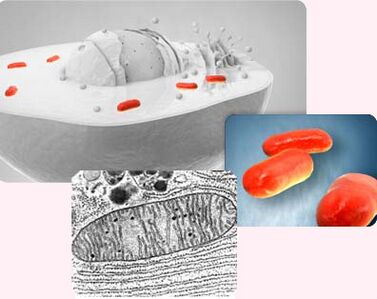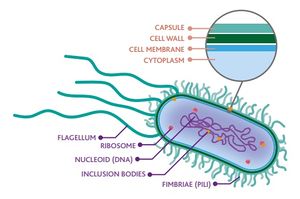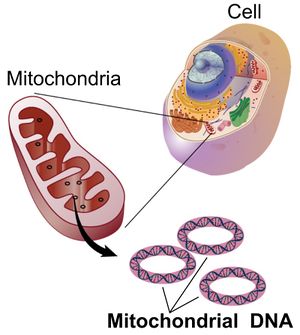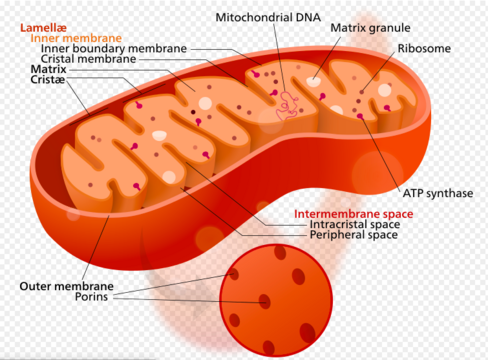Mitochondria
Original Editor - Lucinda hampton
Top Contributors - Lucinda hampton and Kim Jackson
Introduction[edit | edit source]
Present in nearly all types of human cell, mitochondria are vital to our survival, acting as the power plants of the cell. They are surrounded by two membranes, and have their own genome. They are involved in other tasks, such as signaling between cells and cell death ie apoptosis. They divide independently of the cell in which they reside, meaning mitochondrial replication is not coupled to cell division. Some of these features are holdovers from the ancient ancestors of mitochondria, which were likely free-living prokaryotes. Mitochondrial division is stimulated by energy demand, so cells with an increased need for energy contain greater numbers of these organelles than cells with lower energy[1] eg mature red blood cells have none at all, liver cells can have more than 2,000. Around 40 percent of the cytoplasm in heart muscle cells is taken up by mitochondria.[2]
Although mitochondria are often drawn as oval-shaped organelles, they are constantly dividing (fission) and bonding together (fusion). So, in reality, these organelles are linked together in ever-changing networks[3].
Origins[edit | edit source]
Our primordial ancestor was a simple single-celled creature, living in a long-term rut of evolutionary stagnation. Then something dramatic happened, one of the cells engulfed another and enslaved it as a perpetual source of energy for its host.
The increase in available energy to the cell powered the formation of more complex organisms with multiple cells, eyes, and brains. As the two species became intertwined (sharing some of their DNA and delegating specific cellular tasks) they eventually formed the most intimate of biological relationships. Two separate species became one. These energy slaves are the mitochondria, and there are hundreds or even thousands of them inside every one of your cells (with the exception of red blood cells) and in every other human alive.
Mitochondria still resemble their bacterial origin in appearance, but we can no longer exist without them, nor they without us. The evolutionary explosion powered by mitochondria is evident by the fact they are found in every complex multicellular organism that has ever existed, from giraffes to palm trees, mushrooms and dinosaurs[4].
Mitochondrial DNA[edit | edit source]
Although most of our DNA is kept in the nucleus of each cell, mitochondria have their own set of DNA. Interestingly, mitochondrial DNA (mtDNA) is more similar to bacterial DNA. The mtDNA holds the instructions for a number of proteins and other cellular support equipment across 37 genes. The human genome stored in the nuclei of our cells contains around 3.3 billion base pairs, whereas mtDNA consists of less than 17,000.
Unlike the nuclear genome, the mitochondrial genome is small, circular, and uses a different DNA code. The mitochondrial genome slinks its way across generations by stowing away within mitochondria harboured in each egg, and as such, is passed down from the mother only. This is different to the nuclear genome, half of which is inherited from your father and the other half from your mother. Mitochondria do not contain anywhere near the amount of DNA needed to code for all mitochondria-specific proteins, however, a billion or so years of evolution could account for a progressive loss of independence.[2]
Structure[edit | edit source]
Mitochondria features are small in size (between 0.75 and 3 micrometers), and are not visible under the microscope unless they are stained.
They have two membranes, an outer one and an inner one, and an intermembrane (space) between them. Each membrane has different functions.
- Outer membrane: Small molecules can pass freely through the outer membrane. This outer portion includes proteins called porins, which form channels that allow proteins to cross. The outer membrane also hosts a number of enzymes with a wide variety of functions.
- Inner membrane: holds proteins that have several roles. Because there are no porins in the inner membrane, it is impermeable to most molecules. Molecules can only cross the inner membrane in special membrane transporters. The inner membrane is where most ATP is created. The Cristae are the folds of the inner membrane. They increase the surface area of the membrane, therefore increasing the space available for chemical reactions. The Matrix is the space within the inner membrane. Containing hundreds of enzymes, it is important in the production of ATP. Mitochondrial DNA is housed here.[3]
Function[edit | edit source]
The best-known role of mitochondria is energy production (however only about 3 percent of the genes needed to make a mitochondrion go into its energy production equipment). Most ATP is produced in mitochondria through a series of reactions, known as the citric acid cycle or the Krebs cycle. Energy production mostly takes place on the folds or cristae of the inner membrane, with mitochondria converting chemical energy from the food we eat into an energy form that the cell can use. This process is called oxidative phosphorylation. Endurance training can increase the volume and number of mitochondria (the magnitude of these changes are dependent on the frequency and intensity of training).[5]
Other functions:
- Cell death: apoptosis) is an essential part of life. As cells become old or broken, they are cleared away and destroyed. Mitochondria help decide which cells are destroyed. Mitochondria release cytochrome C, which activates caspase, one of the chief enzymes involved in destroying cells during apoptosis. Because certain diseases, such as cancer, involve a breakdown in normal apoptosis, mitochondria are thought to play a role in the disease.
- Storing Calcium: calcium is vital for a number of cellular processes. Eg releasing calcium back into a cell can initiate the release of a neurotransmitter from a neurone or hormones from endocrine cells. Calcium is also necessary for muscle function, fertilization, and blood clotting, among other things. Because calcium is so critical, the cell regulates it tightly. Mitochondria play a part in this by quickly absorbing calcium ions and holding them until they are needed. Other roles for calcium in the cell include regulating cellular metabolism, steroid synthesis, and hormone signaling.
- Heat production: when we are cold, we shiver to keep warm. But the body can also generate heat in other ways, one of which is by using a tissue called brown fat. During a process called proton leak, mitochondria can generate heat. This is known as non-shivering thermogenesis. Brown fat is found at its highest levels in babies, when we are more susceptible to cold, and slowly levels reduce as we age[3].
Mitochondria in Health and Diseases[edit | edit source]
Mitochondria have been recognized as the “power plants” that provide over 90% of ATP required for cell metabolism. Also, they are engaged in other aspects of cell metabolism and function and participate in the regulation of ion homeostasis, cell growth, redox status, cell signaling, and, thus, play a pivotal role in both cell survival and cell death mechanisms[6].
- Due to their central role in cell life and death, mitochondria are also involved in the pathogenesis and progression of numerous human diseases eg cancer, neurodegenerative and cardiovascular disorders, diabetes, traumatic brain injury, and inflammation[3].
- During life, it’s inevitable that mutations will occur in the mitochondrial genome in an individual’s neurons, muscle, and all other cells. Compelling work now suggests that the accumulation of these mistakes may contribute to the progressive nature of late-onset degenerative diseases such as Alzheimer’s and Parkinson’s[7].
- see also mitochondrial myopathies
References[edit | edit source]
- ↑ Nature Mitochondria Available from:https://www.nature.com/scitable/topicpage/mitochondria-14053590/ (accessed 9.1.2021)
- ↑ 2.0 2.1 Experimental biosciebnce Evolutionary Origin of Mitochondria AVAILABLE FROM:https://www.ruf.rice.edu/~bioslabs/studies/mitochondria/mitorigin.html (accessed 9.1.2021)
- ↑ 3.0 3.1 3.2 3.3 Medical news today Mitochondria Available from:https://www.medicalnewstoday.com/articles/320875#structure (accessed 9.1.2021)
- ↑ Tought co. Mitochondia Available from:https://qbi.uq.edu.au/brain/brain-anatomy/mitochondria-what-are-they-and-why-do-we-have-them (accessed 9.1.2021)
- ↑ Hickson RC. Skeletal muscle cytochrome c and myoglobin, endurance, and frequency of training. J Appl. Physiol. 1981;51:746-9.
- ↑ Javadov S, Kozlov AV, Camara AK. Mitochondria in Health and Diseases.2020 Available from:https://www.ncbi.nlm.nih.gov/pmc/articles/PMC7290976/ (accessed 10.1.2021)
- ↑ QBI Mitochondria Available from:https://qbi.uq.edu.au/brain/brain-anatomy/mitochondria-what-are-they-and-why-do-we-have-them (accessed10.1.2021)











